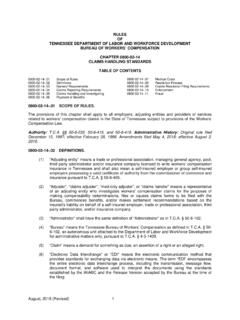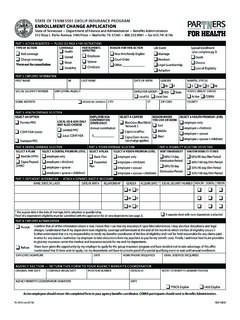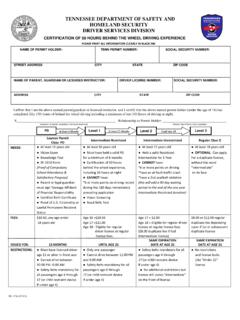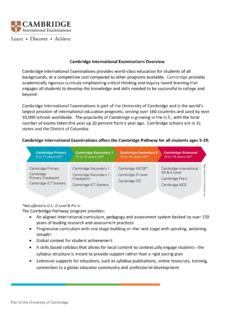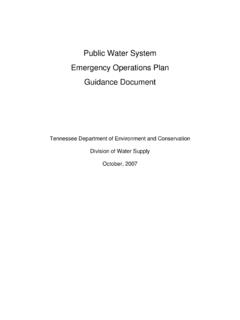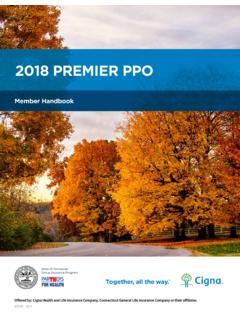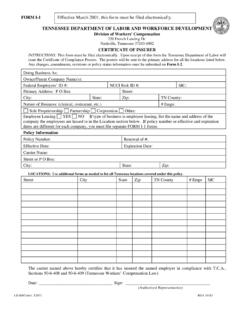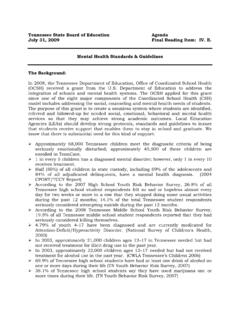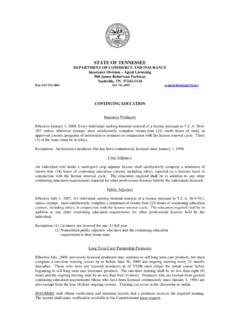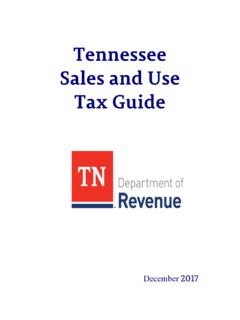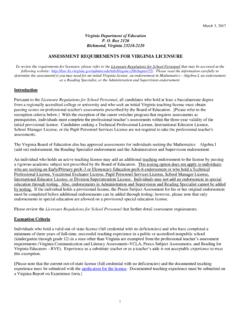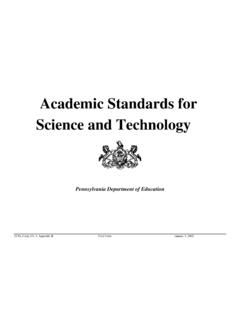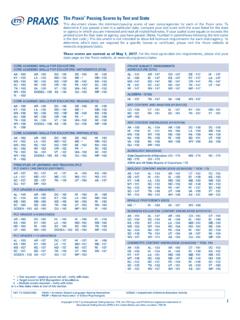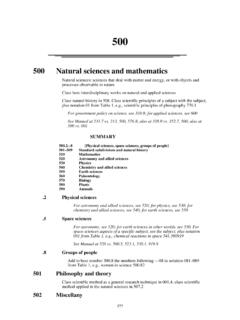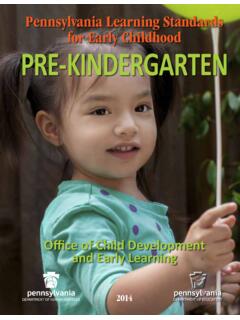Transcription of Tennessee Academic Standards for Science
1 1 Tennessee Academic Standards for Science Tennessee Science Standards Value Statement Tennessee possesses a citizenry known to be intelligent, knowledgeable, hardworking, and creative. Tennessee s schools offer Science programs that introduce a broad range of important subjects along with opportunities to explore topics ranging from nuclear energy Science to breakthrough medical discoveries. The challenge of developing and sustaining a population of scientifically informed citizens requires that educational systems be guided by Science curriculum Standards that are academically rigorous, relevant to today s world, and attendant to what makes Tennessee a unique place to live and learn. To achieve this end, school systems employ Standards to craft meaningful local curricula that are innovative and provide myriad learning opportunities that extend beyond mastery of basic scientific principles.
2 The Tennessee Academic Standards for Science Standards include the necessary qualities and conditions to support learning environments in which students can develop knowledge and skills needed for post-secondary and career pursuits, and be well-positioned to become curious, lifelong learners. Declarations: Tennessee s K-12 Science Standards are intended to guide the development and delivery of educational experiences that prepare all students for the challenges of the 21stcentury and enable them to: Develop an in-depth understanding of the major Science disciplines through a series of coherent K-12 learning experiences that afford frequent interactions with the natural and man-made worlds; Make pertinent connections among scientific concepts, associated mathematical principles, and skillful applications of reading, writing, listening, and speaking; Recognize that certain broad concepts/big ideas foster a comprehensive and scientifically-based picture of the world and are important across all fields of Science .
3 Explore scientific phenomena and build Science knowledge and skills using their own linguistic and cultural experiences with appropriate assistance or accommodations; Identify and ask appropriate questions that can be answered through scientific investigations; Design and conduct investigations independently or collaboratively to generate evidence needed to answer a variety of questions; Use appropriate equipment and tools and apply safe laboratory habits and procedures; Think critically and logically to analyze and interpret data, draw conclusions, and develop explanations that are based on evidence and are free from bias; Communicate and defend results through multiple modes of representation ( , oral, mathematical, pictorial, graphic, and textual models); Integrate Science , mathematics, technology, and engineering design to solve problems and guide everyday decisions; Consider trade-offs among possible solutions when making decisions about issues for which there 2 are competing alternatives; Locate, evaluate, and apply reliable sources of scientific and technological information; Recognize that the principal activity of scientists is to explain the natural world and develop associated theories and laws.
4 Recognize that current scientific understanding is tentative and subject to change as experimental evidence accumulates and/or old evidence is reexamined; Demonstrate an understanding of scientific principles and the ability to conduct investigations through student-directed experiments, authentic performances, lab reports, portfolios, laboratory demonstrations, real world projects, interviews, and high-stakes 1 Information from the NSTA Position Statements was adapted to compile this document. 3 Table of Contents Section Page Number Background Information and Context Research and Vision of the Standards 4 Crosscutting Concepts 6 Science and Engineering Practices 6 Engineering Technology and Science Practice Standards (ETS) 7 Structure of the Standards 8 Elementary School Progression 8 Middle School Progression 8 High School Progression 10 Grade Level Overviews 10 Shifts in Sequence 11 Disciplinary Core Ideas across Grade Levels 12 Recommended Mathematical and Literacy Skills for Science Proficiency 14 Scientific Literacy vs.
5 Literacy 16 Kindergarten 17 First Grade 21 Second Grade 25 Third Grade 30 Fourth Grade 35 Fifth Grade 40 Sixth Grade 45 Seventh Grade 49 Eighth Grade 53 Biology I 58 Biology II 63 Chemistry I 68 Chemistry II 73 earth and Space Science 78 Ecology 84 Environmental Science 89 Geology 95 Human Anatomy and Physiology 100 Physical Science 106 Physical World Concepts 111 Physics 116 Scientific Research 121 4 Research and Vision of the Standards The ideas driving the development of the Standards are: Improve the coherence of content from grade to grade. Integrate disciplinary core ideas with crosscutting concepts and Science and engineering practices. Promote equity and diversity of Science and engineering education for all learners. Disciplinary Core Ideas and Components: The Framework for K-12 Science Education describes the progression of disciplinary core ideas (DCIs) and gives grade level end points.
6 These core ideas and the component ideas are the structure and organization of the Tennessee Academic Standards for Science . Focusing on a limited number of ideas, grades K-12 will deepen content knowledge and build on learning. The progressions are designed to build on student understanding of Science with developmental appropriateness. The Science and engineering practices are integrated throughout the physical, life, and earth DCI groups shown below. PHYSICAL sciences (PS) PS1: Matter and Its Interactions A. Structure and Properties of Matter B. Chemical Processes C. Nuclear Processes PS2: Motion and Stability: Forces and Interactions A. Forces, Fields, and Motion B. Types of Interactions C. Stability and Instability in Physical Systems PS3: Energy A.
7 Definitions of Energy B. Conservation of Energy and Energy Transfer C. Relationship Between Energy and Forces and Fields D. Energy in Chemical Processes and Everyday Life PS4: Waves and Their Applications in Technologies for Information Transfer A. Wave Properties: Mechanical and Electromagnetic B. Electromagnetic Radiation C. Information Technologies and Instrumentation 5 LIFE sciences (LS) LS1: From Molecules to Organisms: Structures and Processes A. Structure and Function B. Growth and Development of Organisms C. Organization for Matter and Energy Flow in Organisms D. Information Processing LS2: Ecosystems: Interactions, Energy, and Dynamics A. Interdependent Relationships in Ecosystems B. Cycles of Matter and Energy Transfer in Ecosystems C.
8 Ecosystem Dynamics, Functioning, and Resilience D. Social Interactions and Group Behavior LS3: Heredity: Inheritance and Variation of Traits A. Inheritance of Traits B. Variation of Traits LS4: Biological Change: Unity and Diversity A. Evidence of Common Ancestry B. Natural Selection C. Adaptation D. Biodiversity and Humans earth AND SPACE sciences (ESS) ESS1: earth s Place in the Universe A. The Universe and Its Stars B. earth and the Solar System C. The History of Planet earth ESS2: earth s Systems A. earth Materials and Systems B. Plate Tectonics and Large-Scale System Interactions C. The Roles of Water in earth s Surface Processes D. Weather and Climate E. Biogeology ESS3: earth and Human Activity A. Natural Resources B. Natural Hazards C. Human Impacts on earth Systems D.
9 Global Climate Change 6 ENGINEERING, TECHNOLOGY, AND APPLICATIONS OF Science (ETS) ETS1: Engineering Design A. Defining and Delimiting and Engineering Problems B. Developing Possible Solutions C. Optimizing the Solution Design ETS2: Links Among Engineering, Technology, Science , and Society A. Interdependence of Science , Technology, Engineering, and Math (STEM) B. Influence of Engineering, Technology, and Science on Society and the Natural World ETS3: Applications of Science A. Nature of Science Components B. Theory Development and Revision C. Science Practices: Utilization in Developing and Conducting Original Scientific Research D. Practice of Peer Review Crosscutting Concepts These are concepts that permeate all Science and show an interdependent connection among the sciences differentiated from grades K-12.
10 Tennessee state Science Standards have explicitly designed the standard progression to include these crosscutting concepts: Pattern observation and explanation Cause and effect relationships that can be explained through a mechanism Scale, proportion, and quantity that integrate measurement and precision of language Systems and system models with defined boundaries that can be investigated and characterized by the next three concepts Energy and matter conservation through transformations that flow or cycle into, out of, or within a system Structure and function of systems and their parts Stability and change of systems Science and Engineering Practices The Science and engineering practices are used as a means to learn Science by doing Science , thus combining knowledge with skill.
